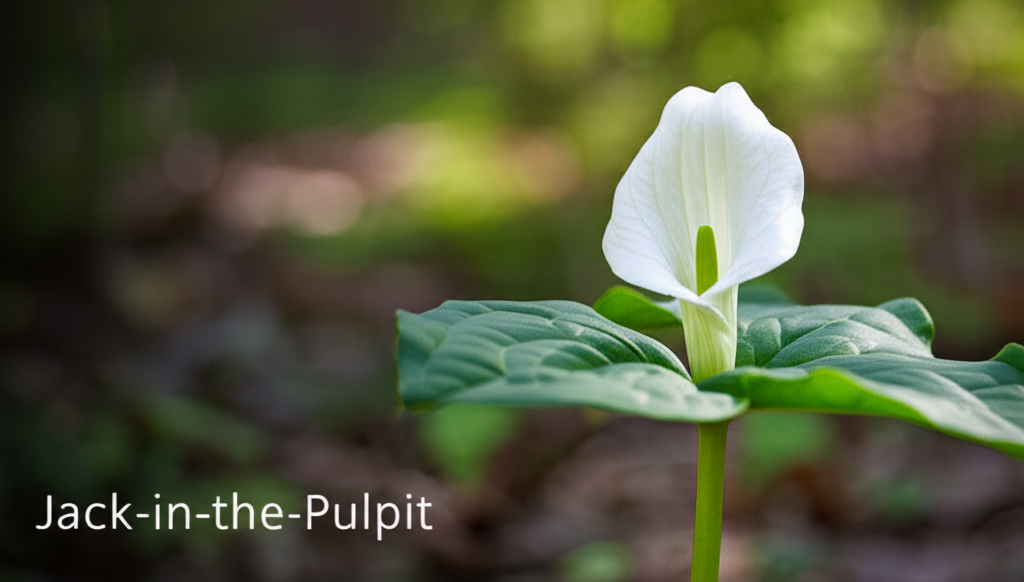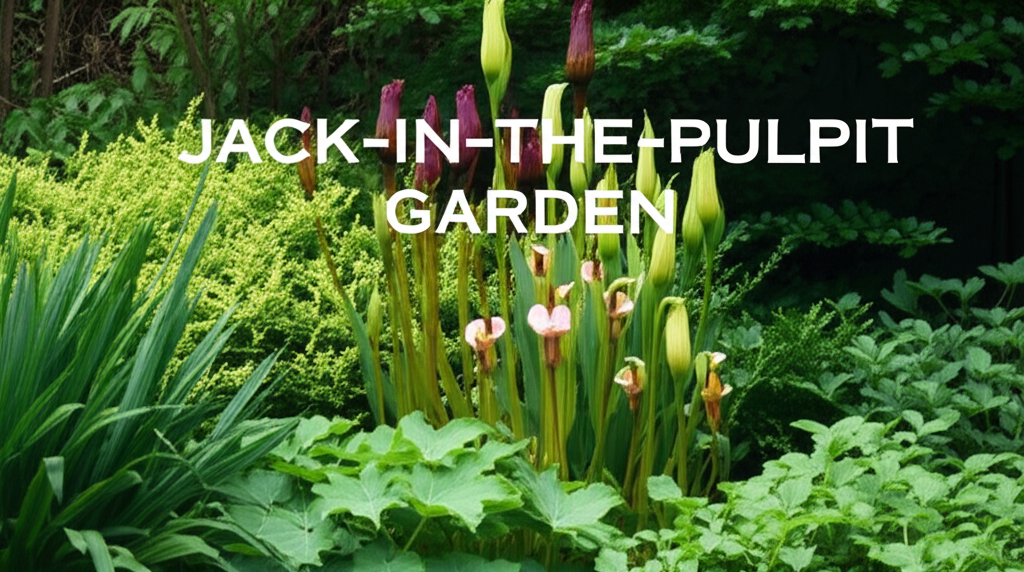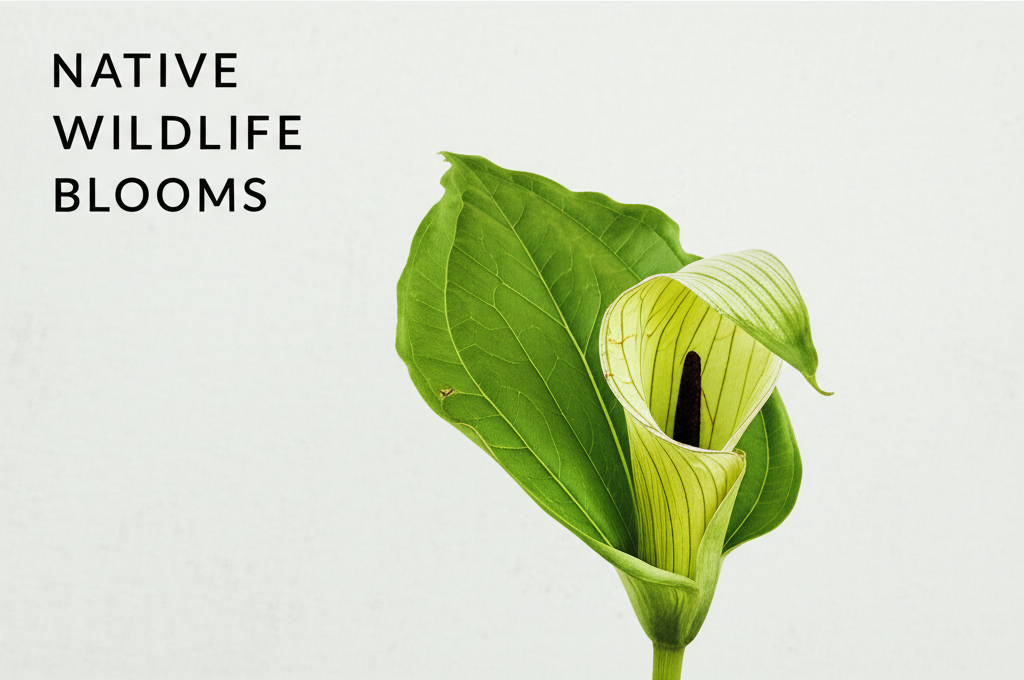Unveiling the Enigmatic Jack-in-the-Pulpit: A Gardener’s Delight
For beginner wildlife gardeners, the quest for plants that are both beautiful and beneficial to local fauna can be a rewarding journey. Among the native treasures of North America, the Jack-in-the-Pulpit (Arisaema triphyllum) stands out as a truly captivating and surprisingly adaptable choice. Its unique spathe and spadix, resembling a clergyman delivering a sermon, have earned it a place in folklore and a special status in woodland gardens. Beyond its striking appearance, this perennial herb offers significant ecological value, providing food and shelter for a variety of wildlife. This article delves into everything a beginner needs to know to successfully cultivate and appreciate the enigmatic Jack-in-the-Pulpit.
What Makes Jack-in-the-Pulpit So Special?
The allure of Jack-in-the-Pulpit lies in its distinctive morphology and life cycle. Its common name perfectly describes its most prominent feature: a hooded spathe, typically green with purple or brownish stripes, arching over a central spadix. This intricate structure serves a crucial purpose in attracting and trapping small insects, which then pollinate the tiny flowers clustered on the spadix.
However, the Jack-in-the-Pulpit’s appeal extends beyond its bloom. It’s a plant that evolves throughout the season, culminating in a vibrant cluster of bright red berries in the late summer and fall, a vital food source for birds and small mammals. Its woodland habitat preference also makes it an excellent companion for other shade-loving natives, contributing to a thriving, biodiverse garden ecosystem.
Key Facts About Jack-in-the-Pulpit

To understand the needs of this fascinating plant, it’s essential to grasp its fundamental characteristics.
| Feature | Description |
|---|---|
| Botanical Name | Arisaema triphyllum |
| Common Names | Jack-in-the-Pulpit, Indian Turnip, Wake Robin |
| Plant Type | Herbaceous Perennial |
| Native Range | Eastern North America |
| Hardiness Zones | 4-9 |
| Sunlight Preference | Partial to Full Shade |
| Soil Preference | Moist, well-draining, humus-rich soil |
| Bloom Time | Late Spring to Early Summer |
| Height | 1-3 feet |
| Wildlife Value | Attracts pollinators, provides food for birds and mammals via berries. |
| Toxicity | Contains calcium oxalate crystals; toxic if ingested raw. |
Cultivating Your Own Jack-in-the-Pulpit: A Step-by-Step Guide
Despite its exotic appearance, Jack-in-the-Pulpit is remarkably forgiving for beginners, provided its basic needs are met. Understanding these requirements will set you on the path to a successful and rewarding gardening experience.
Site Selection: Finding the Perfect Niche
The first crucial step is choosing the right location. Jack-in-the-Pulpit thrives in the conditions it naturally encounters in the wild: the dappled sunlight and moist, nutrient-rich soil of deciduous forests.
Ideal Conditions:
- Shade: Aim for a location that receives partial shade, especially protection from the harsh afternoon sun. A spot under the canopy of deciduous trees is ideal. Morning sun with afternoon shade is also acceptable.
- Soil: The plant prefers consistently moist soil that is rich in organic matter. Amend your garden bed with compost, leaf mold, or well-rotted manure to improve soil structure and fertility. A slightly acidic pH is generally preferred.
- Moisture: While it likes moisture, it also needs well-draining soil to prevent root rot. If your garden soil tends to stay waterlogged, consider incorporating perlite or sand to improve drainage, or planting in raised beds.
Planting Your Jack-in-the-Pulpit
You can acquire Jack-in-the-Pulpit from reputable native plant nurseries, either as dormant corms or as established plants.
Planting Corms:
- Timing: The best time to plant corms is in the fall, allowing them to establish roots before winter.
- Depth: Plant the corms about 3-4 inches deep with the pointy end facing upwards.
- Spacing: Space them about 6-12 inches apart to allow for mature growth and spread.
Planting Established Plants:
- Timing: This can be done in early spring as soon as the ground is workable, or in the fall after the foliage has died back.
- Technique: Dig a hole twice the size of the root ball. Gently remove the plant from its nursery container, loosen any circling roots, and place it in the hole so that the top of the root ball is level with the soil surface. Backfill the hole and water thoroughly.
Care and Maintenance: Nurturing Your Native Gem
Once planted, Jack-in-the-Pulpit is relatively low-maintenance, especially when its environmental needs are met.
Watering:
- Keep the soil consistently moist, especially during dry spells. Water deeply at the base of the plant. Avoid letting the soil dry out completely, but also avoid overwatering.
Mulching:
- Apply a layer of organic mulch, such as shredded leaves or wood chips, around the base of the plant. This helps retain soil moisture, suppress weeds, and regulate soil temperature.
Fertilizing:
- Jack-in-the-Pulpit generally does not require heavy fertilization. If your soil is rich in organic matter, it will likely thrive without any additional feeding. If you choose to fertilize, use a balanced, slow-release organic fertilizer in the early spring.
Pest and Disease Management:
- In its native habitat, Jack-in-the-Pulpit is quite resilient. Pests are rarely a significant problem. Occasionally, slugs or snails might nibble on the foliage, but this is usually cosmetic. Proper site selection and good air circulation can prevent most issues.
Propagating Jack-in-the-Pulpit
While it can be slow to establish, Jack-in-the-Pulpit can be propagated in a couple of ways.
Seed Propagation:
- Jack-in-the-Pulpit produces bright red berries in the fall. These seeds require a period of cold stratification (exposure to freezing temperatures) followed by a warm period, and then another cold period before germination can occur. This process can take 18-24 months, so patience is key. Sow seeds in fall in a protected outdoor location or a cold frame.
Division:
- Established plants can be divided in the early spring before new growth emerges. Carefully dig up the plant and divide the corms, ensuring each division has at least one eye or bud. Replant the divisions immediately.
Jack-in-the-Pulpit and Wildlife: A Symbiotic Relationship
One of the primary reasons to include Jack-in-the-Pulpit in a wildlife garden is its contribution to the local ecosystem.
Pollinators:**
- The intricate spathe and spadix are designed to attract small flies and gnats. These insects, drawn in by the flower’s scent and often trapped temporarily within the spathe, are crucial for pollinating the plant.
Bird and Mammal Food Source:
- In late summer and fall, the plant produces striking clusters of bright red berries. These berries are a valuable food source for various birds, including thrushes, robins, and blue jays, as well as small mammals like chipmunks and squirrels.
Habitat Creation:
- As an understory plant, Jack-in-the-Pulpit contributes to the layered structure of a woodland garden, providing shelter and microhabitats for beneficial insects and other small creatures.
Comparing Jack-in-the-Pulpit to Other Native Woodland Plants
For those looking to create a cohesive native woodland garden, understanding how Jack-in-the-Pulpit fits in with other suitable plants is beneficial.
| Plant | Sunlight Preference | Soil Preference | Bloom Time | Wildlife Benefit | Ease of Care (Beginner) |
|---|---|---|---|---|---|
| Jack-in-the-Pulpit | Partial to Full Shade | Moist, humus-rich, well-draining | Late Spring – Early Summer | Pollinators, Bird/Mammal Berries | Moderate (needs consistent moisture) |
| Wild Ginger (Asarum canadense) | Full Shade | Moist, rich, acidic | Early Spring | Ground cover, supports specific pollinators | Easy |
| Foamflower (Tiarella cordifolia) | Partial to Full Shade | Moist, well-draining, humus-rich | Late Spring | Attracts pollinators | Easy to Moderate |
| Trillium (various species) | Partial to Full Shade | Moist, well-draining, humus-rich | Spring | Pollinators, seed dispersal by ants | Moderate (can be slow to establish) |
| Ostrich Fern (Matteuccia struthiopteris) | Partial to Full Shade | Moist, fertile | N/A (foliage plant) | Provides structure and habitat | Easy |
Pros and Cons of Growing Jack-in-the-Pulpit
Every plant has its advantages and disadvantages. Knowing these upfront can help manage expectations and ensure a successful gardening experience.
| Pros | Cons |
|---|---|
| Unique and fascinating bloom structure. | Contains calcium oxalate crystals, making it toxic if ingested raw (important to note for gardens with pets or very young children). |
| Excellent food source for birds and small mammals with its bright red berries. | Can be slow to establish from seed, requiring significant patience. |
| Supports native pollinators, contributing to biodiversity. | Requires consistently moist soil; may struggle in dry conditions. |
| Aesthetically pleasing foliage even after the bloom fades. | The ephemeral nature of its bloom means it’s a transient spectacle. |
| Relatively low maintenance once established. | Over-collection from the wild is a concern; sourcing from reputable nurseries is vital. |
Addressing Common Beginner Concerns
It’s natural for new gardeners to have questions. Here are a few common concerns regarding Jack-in-the-Pulpit.
“My plant hasn’t flowered yet. Is something wrong?”
It is common for young Jack-in-the-Pulpit plants, especially those grown from seed or recently transplanted corms, to take several years to reach maturity and produce a flower. Ensure your plant is in the right conditions (shade, moisture, good soil) and give it time. Healthy foliage is a good sign of establishment.
“Why do the leaves sometimes die back in mid-summer?”
Jack-in-the-Pulpit is a woodland plant that often experiences a dry period in late summer when its deciduous tree canopy casts more shade. Some plants have adapted to go dormant during this time, pulling their energy back into the corm. This is a natural process and not necessarily a cause for concern.
“Can I plant it with other shade-loving plants?”
Absolutely! Jack-in-the-Pulpit is an excellent companion for other native woodland plants such as Wild Ginger (Asarum canadense), Foamflower (Tiarella cordifolia), various native ferns, and Trilliums. These plants share similar environmental preferences, creating a harmonious and ecologically rich woodland garden.
Conclusion: Embrace the Charm of Jack-in-the-Pulpit
The Jack-in-the-Pulpit is more than just a plant; it’s a conversation starter, a natural wonder, and a valuable contributor to local wildlife. For beginner wildlife gardeners, it offers a unique opportunity to connect with the intricate beauty of native flora and fauna. By understanding its simple needs for shade, moisture, and rich soil, you can successfully cultivate this captivating perennial and enjoy its distinctive charm for years to come. As your garden matures, you’ll find that this enigmatic plant, with its sermon-delivering bloom and life-sustaining berries, becomes a beloved focal point, enriching your understanding of the natural world.

